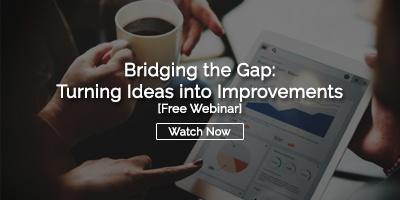 In my last post, we reflected on PDSA/PDCA and how different it becomes when thought of as a true cycle, rather than if considered in a linear fashion as it is written.
In my last post, we reflected on PDSA/PDCA and how different it becomes when thought of as a true cycle, rather than if considered in a linear fashion as it is written.
When we write the improvement cycle as linear, we start at P, which places the emphasis on the plan (noun) you intend to implement. But if P is understood to mean ‘planning’ (verb), the emphasis is on first constructing a plan. Thinking of the P in this way, it becomes clear that you must first understand the current circumstances and make an honest appraisal of what can be done, given the way your organization works.
In other words, when the cycle starts at Study, your Planning is much more likely to result in an ideal change - one that works and is workable to both address the issue at hand and be feasible given the way work is done.
However, this leads to the question how much Planning should you do?
Listen to this Post and Subscribe to the Podcast!
Highly visible current events, described in the last post, nicely demonstrated that jumping into a change without enough Planning derails the effort before it ever gets off the ground, and of even greater significance, causes a big hit to credibility.
When you look at PDSA in a linear way starting with Plan, you naturally focus on what you’re going to get done. But what if the thing you intend to accomplish isn’t actually the best option for solving your problem? Without enough vetting to be sure the idea even has a chance, your Plan just fizzles and fails to gain the necessary support. I’m sure you’ve seen this happen, and the result is not pretty - conflict, resistance, and dueling solutions abound as everyone concocts their own narrative about your Plan, each brain defending the only path it sees to success.
On the other hand, too much Planning is a waste of time because no matter how much energy you devote, there is no way to fully anticipate all the unintended consequences and unexpected results present in even the best-devised plan. Therefore, extreme vetting of ideas is not necessarily the best path, either.
Rather, there needs to be enough vetting - not too much and not too little.
How then to find the sweet spot?
When P means Planning, beginning the cycle at Study shifts attention toward an understanding of not only the current situation, but also an understanding of what matters not just to you, but to everyone involved.
Rather than everyone focusing on a plan that may not be the best choice at that time in those circumstances, shifting the focus a step before deciding on the plan directs attention toward a destination everyone is willing to invest themselves in and work hard toward. Their energy and attention moves from protecting their own interests to working toward something of value. Instead of resistance, you get engagement, as those very same brains now see enough potential to commit time and energy to figure out a workable solution. A shared outcome is the tangible product of this focus; it illuminates the sweet spot.
Arriving at a shared outcome indicates you have ‘Vetted the P’ with just the right amount of planning. How can you know when you have achieved a shared outcome? Answer these three questions:
- What is it that each and every person can get on board with?
- What has everyone committed to work toward?
- Will everyone follow through on their commitment?
If any one of these three questions don’t work out, you didn’t really have a shared outcome. If you’re trying to hold people accountable to what you thought was a shared outcome, but really isn’t, it means that you’re placing your emphasis on “the plan” rather than the Study. This kind of accountability results in dueling solutions as you try and try to enforce a plan that either doesn’t work or is not workable.
Crafting an ideal change does not start with the change you want, although this is often what we do. After all, that is the way your brain prefers to operate - by jumping straight to your solution. Like PDSA, reaching an ideal change does not start at the Plan. It starts at Study. A shared outcome is the first step in a two-step process to reach an ideal change, and you can’t skip steps and expect to get there.
Only when there is a firm shared outcome in hand is it time to move forward through the Do, Study, and Adjust steps. Trialing and testing the possible options identifies those unexpected results and unintended consequences, revealing a proper choice and keeping the cycle going.
Now sometimes, a shared outcome is established, but after trials and testing, you still find yourself in dueling solutions. The shared outcome you thought you had turns out not to be so shared.
This is frustrating no doubt, but actually is an important realization. The trialing and testing has caused people’s brains to reprioritize their sorting criteria. What really matters turns out to be different than previously thought. While there may have genuinely been agreement earlier on what mattered, their Hidden Brain is now telling them otherwise. From the outside, it looks like resistance or failure to follow through, but it really indicates something important that you need to look deeper into. People are likely unable to articulate why they now have a problem with the plan when they didn’t before, because this prioritization takes place largely in the Hidden Brain, outside of awareness. Their mind changed its view.
But really, no harm, no foul. It’s a clear signal that rather than persist with the Plan, it’s time to revisit the shared outcome. Rather than continue to argue for, rationalize, and hammer away at the plan, it’s time to tackle the resistance head on. As the saying goes, ‘pay me now or pay me later. It’s your choice.’ You can move forward now or finally figure it out six months from now. The question is: does the culture of your organization permit people to change their minds and acknowledge this as a valuable step in the process of changing?
KaiNexus can be so helpful here. When tackling an initiative, set up the project in two stages. Label this first stage “Shared Outcome Development.” People first input their concerns, potential risks, and what they need from the change. This gives the opportunity to weigh in on the measure of success they will be judged by, and what they fear they will be held accountable for if the change does not work as anticipated. Use this stage to evolve the idea about what the plan might look like, what they need to get out of it, what it needs to be, and what it needs to do. In this way, you can guide your organization through starting the cycle at Study, gain a shared outcome first, and do just the right amount of planning.
Once everyone is on board with that shared outcome, you are ready to re-categorize the project as in the ‘Trial and Test’ stage. Identify the options that move everyone toward the shared outcome. Which of the various options does everyone agree to trial? This is D/S/A. Use KaiNexus to track and examine the results. Minds may change; welcome this as a chance to get to the best option. The ultimate goal is an ideal change - a choice that works and is workable, and the improvement cycle can begin anew.



Add a Comment